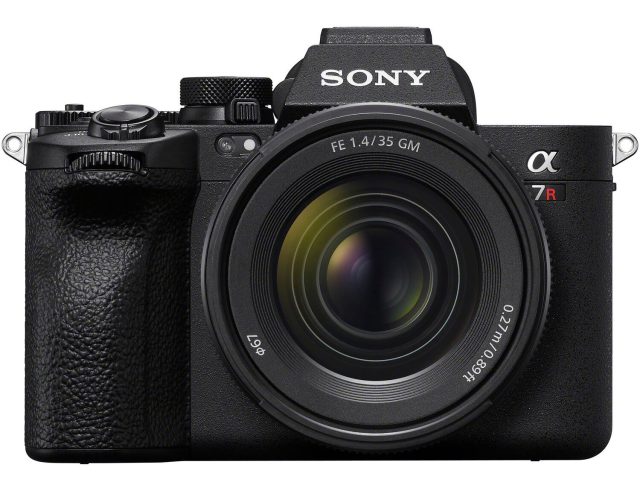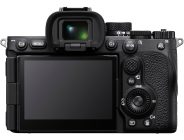Announced
Production status
System
Sony a7R V
35mm AF digital mirrorless camera
Specification
| Format: | |
| 35mm full frame | |
Imaging sensor: | 35.7 × 23.8mm CMOS sensor |
Resolution: | 9504 × 6336 - 60 MP |
Sensor-shift image stabilization: | Yes |
| Sony E [18mm] | |
| Shutter: | |
Type: | Focal-plane |
Model: | Electronically controlled |
Speeds: | 30 - 1/8000 + B |
| Exposure: | |
Exposure metering: | Through-the-lens (TTL), open-aperture |
Exposure modes: | Programmed Auto |
| Aperture-priority Auto | |
| Shutter-priority Auto | |
| Manual | |
| Physical characteristics: | |
Weight: | 723g |
Dimensions: | 131.3x96.9x82.4mm |
Manufacturer description
SAN DIEGO, Oct. 26, 2022 /PRNewswire/ -- Sony Electronics Inc. announced the Alpha 7R V (model ILCE-7RM5) as the newest R series camera in its acclaimed line of Alpha mirrorless interchangeable lens cameras. The Alpha 7R V combines Sony's highest resolution image sensor in an Alpha camera with a new AI (artificial intelligence) processing unit dedicated to AI-based image recognition – a first in any Alpha camera – as well as the powerful BIONZ XR™ image processing engine – a first in the "R" full-frame lineup. The combination of the high-resolution sensor and these processors enables new breakthroughs in subject recognition and capture for both still photography and video.
The new Alpha 7R V offers 61.0MP still images plus the most effective 8-step image stabilization system ever offered in any of Sony's Alpha cameras, as well as refined 8K movie recording, a new 4-axis multi-angle LCD monitor, high-speed communication functions, high-level operability and smooth workflow integration. Sony's newest camera is ideal for professionals who need a first-class high-resolution imaging tool.
"The newest addition to our Alpha 7R lineup is the perfect example of our relentless drive to develop industry-leading imaging technology," said Yang Cheng, Vice President, Imaging Solutions, Sony Electronics Inc. "We are thrilled to introduce the all-new Alpha 7R V with high-resolution and extremely advanced AI integrations that deliver next-generation autofocus performance. We are excited to see what our community creates with the new Alpha 7R V."
Improved AF Accuracy Based on Newly Developed AI Processing Unit
The Alpha 7R V features next-generation AF Real-time Recognition AF, with advanced accuracy and broader subject recognition thanks to a new AI (artificial intelligence) processing unit with deep learning. The state-of-the-art AI processing uses detailed information about human form and pose estimation to dramatically improve recognition accuracy beyond systems which only detect face and eye and make full use of its potential. Real-time Recognition AF, using AI subject recognition, has been developed to include several subject types, including animals, vehicles and insects. The Alpha 7R V also includes continuous shooting at up to 10 fps with AF/AE tracking.
In addition to the advanced AI technology, the Alpha 7R V includes improvement to many beloved features from other cameras in Sony's Alpha series that are now included for the first time in Sony's 7R series:
- Tenacious Real-time Tracking
- Faster and more precise wide-area, high-density AF system
- Silent, vibration-free shootingvii at up to 7 fps
- Continuously shoot up to 583 compressed RAW images at high speed
The Alpha 7R V also includes focus features that support high resolution including full-time DMF (direct manual focus), and focus bracketing, a highly-requested capability that allows for focus stacked images.
Extraordinary Resolution Known to Sony's Alpha 7R Series
The Alpha 7R V was designed to deliver overwhelming detail thanks to the latest BIONZ XR™ image processing engine and a 35mm full-frame back-illuminated Exmor R™ CMOS image sensor with approximately 61.0 effective megapixels. The latest BIONZ XR image processing engine ensures that the resolution potential of the camera's sensor is fully utilized to deliver the highest resolution at low sensitivity in the Alpha series thus far. This enables sensitivity settings from ISO 100 to ISO 32000 for both stills and movies and wide dynamic range with 15 stops for stills.
The Alpha 7R V's entire image stabilization system has been updated with a high-precision image stabilization unit, advanced gyro sensors, and optimized image stabilization algorithms for stills and video. In addition to up to the 8-step compensation effect for stills, the new stabilization algorithm provides precise detection and control right down to the single-pixel level, taking full advantage of the sensor's 61.0-megapixel resolution potential to bring out the finest subject details. Sony's newest camera also offers upgraded Pixel Shift Multi Shooting, which takes advantage of the precision in-body image stabilization system control, capturing multiple pixel-shifted images that are later composited using a computer to achieve overwhelming resolution in a single image. Using the latest version of Imaging Edge Desktop™ Ver.3.5 computer application, small pixel-level movements, such as a shift in the subject's position or leaves on a tree, are automatically detected and corrected for optimized compositing can be achieved. 16-image composites with approximately 240.8 million pixels (19,008 x 12,672 pixels) can be produced from data that is equivalent to approximately 963.2 million pixels. The Alpha 7R V also supports precise and versatile external flash control for additional creative flexibility. Additionally, when in challenging lighting conditions the Alpha 7R V effectively suppresses flickering from artificial lights for stills and video.
Additional features that offer flexibility for still photography includes:
- Addition of Lossless RAW image compression and selectable RAW image sizes and quality
- Greatly expanded focus and exposure bracketing
- Creative Look settings for stills and videos in camera
- High-quality HEIF images with high compression efficiency
- Wide brightness range for large screen viewing.
Cinematic Video Capabilities
In addition to incredible still photography capabilities, the Alpha 7R V offers advanced video capabilities. Sony's newest camera delivers 8K 24/25p video, 4K video oversampled from 6.2K without binning, a high-efficiency MPEG-H HEVC/H.265 codec, all intra recording, 10-bit 4:2:2 recording, and more for high image quality and flexible editing. It also includes evolved subject recognition for unprecedented real-time tracking reliability, breathing compensation and the ability to use camera metadata for post-processing and advanced in-body image stabilization. In addition to in-body Active mode image stabilization for smoother on-the-go recording, the Alpha 7R V is compatible with select lenses that include built-in image stabilization for even more stable framing and smooth footage.
Operability and Reliability
The Alpha 7R V pairs outstanding reliability for professional needs in both stills and videos with a compact, lightweight form factor. The Alpha 7R V includes a new 4-axis multi-angle LCD monitor that combines the utility of a conventional tilting monitor with side-opening vari-angle flexibility, and an electronic viewfinder with 9.44 million dots. The Alpha 7R V also includes two CFexpress Type A/SDXC compatible media slots and a brand-new menu system with touch control and a wide range of customizable functions.
The Alpha 7R V also allows professionals to optimize their workflow with updated connectivity for improved support. Data can be transferred at high speed over Wi-Fi (802.11ac) 2x2 MIMO or a wired SuperSpeed USB 10Gbps connection via a USB-C® port. In addition to allowing efficient remote shooting as well as still and movie file transfers, new USB streaming features support UVC/UAC, allowing direct streaming from the camera even in 4K (QFHD) resolution with audio as well.
Based on feedback from professionals, the Alpha 7R V includes improved heat dissipation for extended recording times, an upgraded dust and moisture resistant design, a durable magnesium alloy chassis, and other refinements for maximum reliability in challenging working environments.
The Alpha 7R V is also compatible with the new PCK-LG3 Screen Protect Glass Sheet, which maintains touch sensitivity while protecting the LCD monitor against stains and fingerprints.
Designed for Professionals with Sustainability in Mind
Measures have been taken to reduce the environmental footprint of this product at various stages of its life cycle: from product development through supply chain, production, and packaging. Sony aims to inspire through efficient use of energy and resources. Recycled plastic including SORPLAS™ were partially used for the camera body. In addition, manufacturing takes place at a facility using renewable energy.
Sony is working towards the use of plastic free packaging materials that provide ample protection against shock and impact. Plant-based non-woven fabrics are used for product bags. All of these considerations help to minimize environmental impact.



